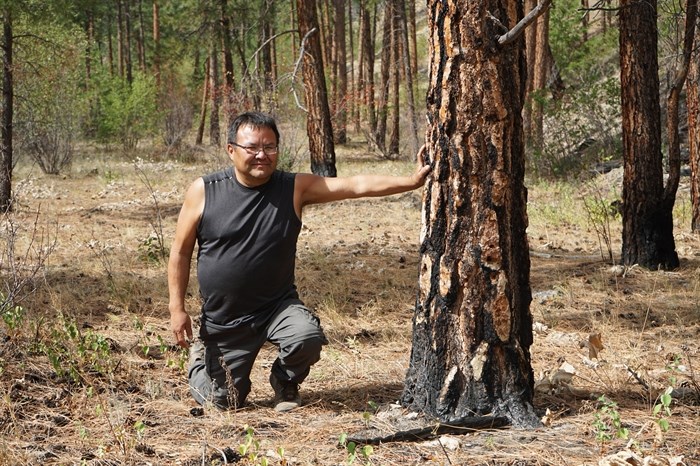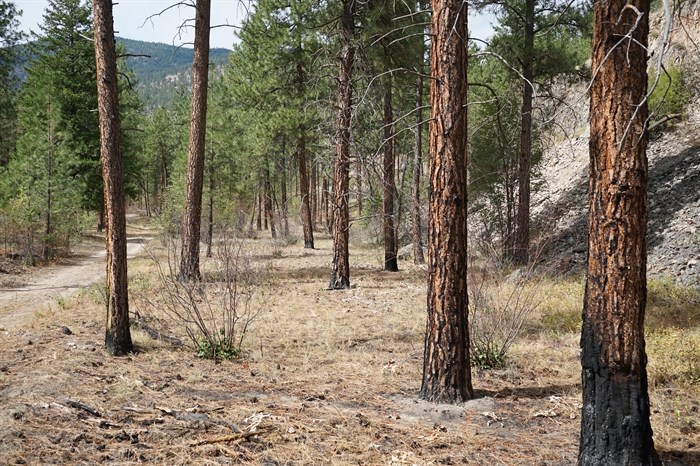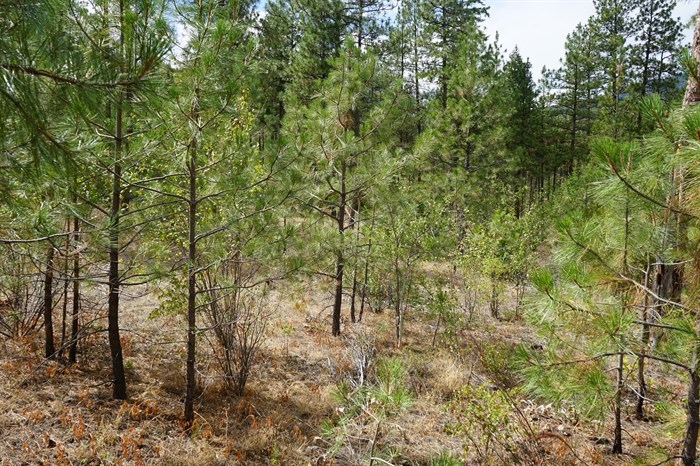
Penticton Indian band councillor Tim Lezard poses beside a charred tree in a well-managed section of forest, as he was part of a team that executed a prescribed burn there four months earlier. The tree is healthy as its bark has evolved to withstand the heat from low-intensity burns.
(DAN WALTON / iNFOnews.ca)
August 29, 2021 - 6:00 PM
As B.C. ponders a future that appears to include more wildfires, it wasn't always like this. First Nations have long used fire to improve forests.
Prescribed burnings at the Penticton Indian Band have traditionally taken a holistic approach – fire management is only one of the benefits.
“When we traditionally burned, we would burn because they wanted those small trees not to be there,” said Tim Lezard, a councillor with the PIB. His grandmother, Annie Kruger, was a firekeeper who actively managed their land until she passed away in 2003.
Lezard made that comment as he was standing on a forest road, looking into a patch of wilderness that has gone too long without a burn. But if that bushy, crowded forest were to catch fire today, it would be difficult to maintain because so much fuel has built up, including ladder fuels which help the flames spread up into the tree canopies.

The well-managed section of PIB forest that underwent a prescribed burn four months earlier
(DAN WALTON / iNFOnews.ca)
On the other side of the road was a relatively clear section of forest where Lezard was involved in a prescribed burn four months earlier. The trees that were standing were tall and healthy despite having bark around the bottom of their trunks a little black and charred, having easily withstood the flames that rolled through in the springtime.
READ MORE: Logan Lake has written the Fire Smart playbook for other cities, towns to follow
To keep the wilderness well-managed, Lezard said the forested areas within his land should undergo prescribed burning roughly every 10 years. If they grow for too long without fire, they become too thick and management becomes much more onerous. When a wildfire occurs in a well-managed forest, they are usually much easier for emergency crews to manage.
“Something well-managed is easy to keep well-managed,” he said.

An example of an overgrown forest area, where trees of every size prevent other forms of life from fully utilizing the land, while presenting a greater risk in the event of a wildfire.
(DAN WALTON / iNFOnews.ca)
Also as forests become thick with vegetation, they become more difficult to wander through – for both humans and animals.
“Humans are visual, we can’t smell and hear like the animals,” Lezard said. “This is just my personal idea – but think about a long time ago, if we’re going to walk to the creek would you rather walk through the clear forest, or the thick bush?”
Where forests were completely burned, grasslands would be created.
“The ungulates would follow the grass. Bears follow the ungulates,” he said.
When bears roam well-managed forests, they are much easier to spot from far away. Lezard said the presence of bears was largely welcomed, as they increased the amount of food available by snacking on berries, then wandering around pooping out the seeds onto other fertile patches of forest floor. Hunting deer is also easier in a managed forest as they allow for clearer lines of sight.
In one section of band land that was scorched by a wildfire many years ago, Lezard felt like there was an opportunity to keep that area well managed, but too much time has since passed and the land has accumulated too much fuel for a prescribed burn to be applied safely. A few years after that fire, he remembers berry bushes becoming abundant within the impacted areas, but it wasn’t long before shrubs took over and squeezed the edible plants out.
“It looked like it was a great big orchard of Saskatoons.”
With proper forest management, he said, “you can make sure the things you want coming back are coming back.”
READ MORE: IN PHOTOS: Controlled burns helping Kenna ecosystem
Although Lezard and a team of about 10 people conducted a successful burn earlier in 2021, he said the practice is not trending in a positive direction, and that too many sections of local wilderness are currently overgrown.
Lezard’s grandmother knew effective methods for burning patches of their land on rotation each year, and while she shared much of her wisdom with him and other relative before she passed, he feels like her expertise was irreplaceable. Although he has been learning about prescribed burnings for decades, he still considers himself a student on the subject.
“She knew where to burn and when to burn. Her grandma taught her how to do that.”
He remembers her teaching him that every fire is unique, and the most important part about any fire is to set an intention for its purpose.
“When you’re making a fire – you know there’s fires for cooking, fires for garbage, clearing the land – you have to put it in your heart, what the intention is for your fire that you’re making in that moment,” he said. "You have to say your intention out loud."
The first forest fires that Lezard’s ancestors benefited from were probably started naturally by lightning, he predicts, before they became set intentionally.
“It’s accumulated through generations. Eventually they did realize that, from doing it from time to time, over the course of generations that if you do it like this, this is what happens.”
To execute a prescribed burn, Lezard said it’s important to ensure the ground temperature is low enough to prevent the fire from spreading too quickly, so never in the summer months. He said strong guard lines have to be installed and well protected, plan when weather forecasts look favourable, and a team that understands the natural environment needs to be in charge.
“They have to know what the land does, what it’s currently like, and what it could be like. People who know how to make it better for everybody – better for us, for the animal, the plants – thats what it’s about, is balancing it for every living being.”
READ MORE: iN VIDEO: Large prescribed burn on White Rock Lake wildfire successful
To contact a reporter for this story, email Dan Walton or call 250-488-3065 or email the editor. You can also submit photos, videos or news tips to the newsroom and be entered to win a monthly prize draw.
We welcome your comments and opinions on our stories but play nice. We won't censor or delete comments unless they contain off-topic statements or links, unnecessary vulgarity, false facts, spam or obviously fake profiles. If you have any concerns about what you see in comments, email the editor in the link above.
News from © iNFOnews, 2021